Verdict
It falls short of the best on battery life and overall performance, but the Acer Swift X 14 is a superb and capable laptop for creatives needing a portable device.
Pros
- Stylish, slim and light design
- Beautiful 14.5-inch OLED screen
- Fast Core i7 CPU and RTX GPU
- Comfortable ergonomics
Cons
- Disappointing battery life
- Similarly specced machines are faster
-
Colourful and accurate displayIt’s an unusual size with an unusual 2880 x 1800 resolution, but colours and contrast are fantastic. -
Extremely capable creative performanceThis 14-core CPU can work twenty threads at speeds of up to 5GHz. -
Gaming and creator graphics capabilitiesDespite a 50W power limit, this GPU is still capable of speeding up creative apps and running modern games.
Introduction
The Acer Swift X 14 is a new 14.5-inch entry in the growing Swift X family, delivering more performance than most ultraportable laptops in a body you could still call thin and light. What’s more, like previous Swift X laptops, its crowning glory is a beautiful, high-resolution OLED screen.
It’s a spec designed to tempt more demanding creative users looking for a Windows alternative to the MacBook Air or MacBook Pro, but also anyone looking for a high-end device that doesn’t compromise on portability or power.
Sure, you’ll find bigger, faster creative or gaming laptops that make the Swift X 14 look relatively puny, but you’ll have a hard time finding one with these looks, or in a body you could sling in a backpack and lug around with ease when you’re on the move.
Design and Keyboard
- Light 1.55kg weight, slim body and compact footprint
- Strong wired and wireless connectivity
- Excellent keyboard and smooth, glass-feel trackpad
Acer has long produced good-looking laptops, but it doesn’t always get things right and some models don’t look or feel that premium once you go hands-on. That’s not the case with the Swift X 14 – it’s a beauty. It has a compact desktop footprint of just 322.8 x 228.1mm, with a subtly curved, wedge-shaped profile that’s under 18mm thick even at the rear. The ‘Iron’-coloured aluminium chassis has a rather lovely, satin-smooth finish, with any seams only just noticeable on the underside of the unit. There’s barely any give or sign of weakness to be found anywhere, yet it weighs just 1.55kg.
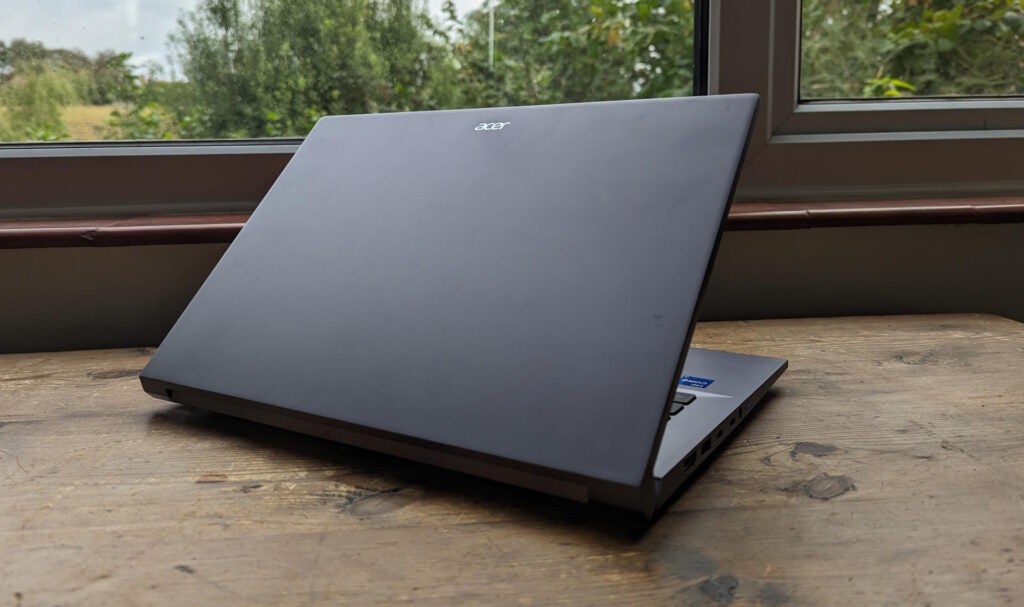
It’s not exactly silent, with the vents underneath and at the rear emitting a fairly constant, low-pitched hiss, but the sound from the redesigned stereo ring fan system is the price you pay for a dedicated GPU, and you can switch it into Silent mode if you’re happy to sacrifice some speed for peace and quiet.
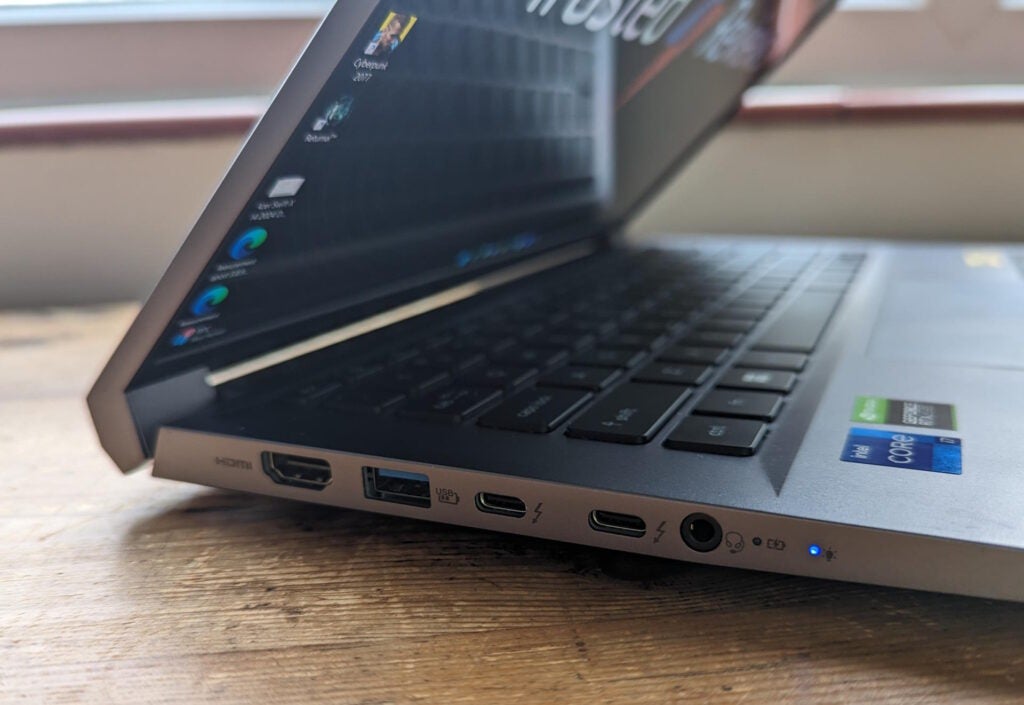
All the connectivity sits on the left and right edges, with two Thunderbolt 4 ports on the left with a single USB Type-A and an HDMI 2.1 output, plus an additional USB Type-A alongside a microSD card slot on the right. Like most of Acer’s new laptops, it supports Wi-Fi 6E as standard, so if you’ve upgraded your router you’ll be good to go.
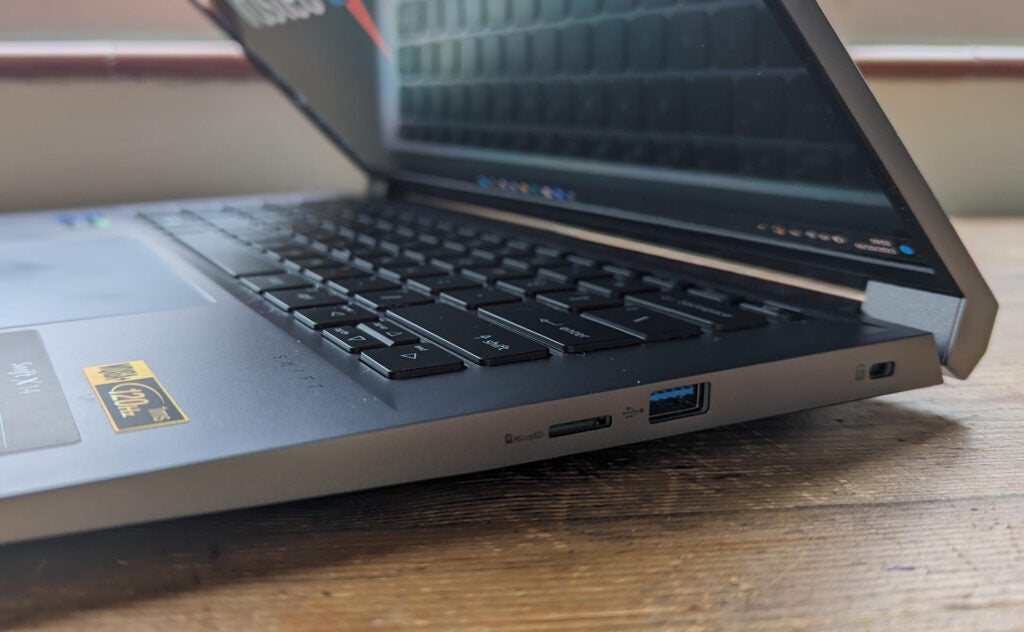
The keyboard is one of the best I’ve encountered on an Acer laptop in some time. It has the well-spaced, flat-topped keys typical of Acer models, and a sensible layout where the Shift, Ctrl, Alt and Enter keys are where you would expect them, and appropriately sized. Our early review version had a US or International layout with no £ sign, but with Windows set to use a UK layout, I only noticed after a good few days of use.
The action is great, with a couple of millimetres travel and satisfying tactile feedback as you press and release each key. I have just one complaint. Acer has placed an on/off key in the top-right corner, just where the Delete key usually sits. As a writer, I hit the Delete key a lot. You can probably guess what happens here, even if the power key doesn’t do a lot unless you hold it down.
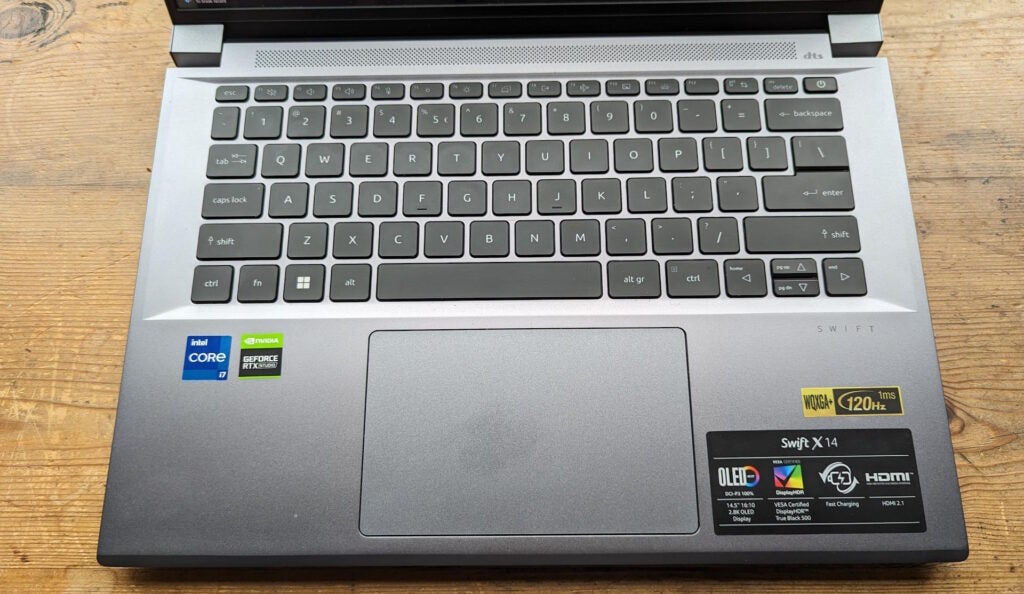
The trackpad uses Acer’s Oceanglass recycled plastic surface, but it feels surprisingly close to regular glass. If anything, I found it slightly too sensitive in use, occasionally registering accidental contact with a palm, causing me to click the wrong thing on the screen. This wasn’t a massive issue, and the generous size and high levels of accuracy make it possible to do some fairly precise and detailed work without reaching for a mouse.
Interestingly, the Oceanglass is the same as used in Acer’s eco-conscious Vero laptops, though that’s where the Swift X 14’s green credentials end, bar the usual energy efficiency provisions. However, the packaging is all cardboard with no plastic inserts, so at least that’s not contributing to global waste.
Display and Sound
- Superb clarity thanks to 14.5-inch size and 1800p resolution
- Good levels of brightness and impressive colour performance
- Great audio for entertainment, chats and meetings
Subjectively, the Swift X 14’s screen is stunning. It’s bright, whites are as pure as you could hope for and the colours are incredibly rich and vibrant. With an unusual 14.5-inch screen size and resolution of 2880 x 1800, it’s fantastically crisp and clear. It’s always a good sign when I spend more time than I really need streaming video to check out different movies, shows and trailers, and I did that a lot while testing Acer’s latest. It’s as brilliant for bingeing Netflix as it is for office work done or editing video.
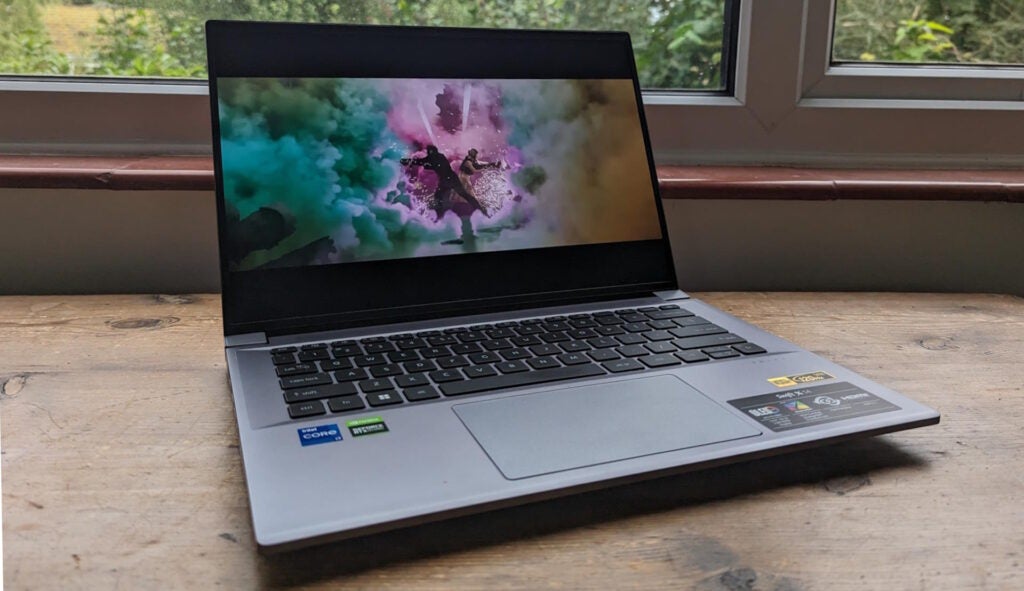
Tested with a colorimeter, it’s every bit as impressive. Max SDR brightness sits at 389 nits, and with the usual OLED black luminance of zero nits, we’re talking infinite levels of contrast – which ought to be good enough for most people. It covers 100% of the sRGB colour gamut, 99.9% of DCI-P3 and 96.5% of Adobe RGB. Don’t know what that means? Don’t worry. If you’re a professional designer, photographer or video editor, this display covers your requirements and gives you accurate colours.
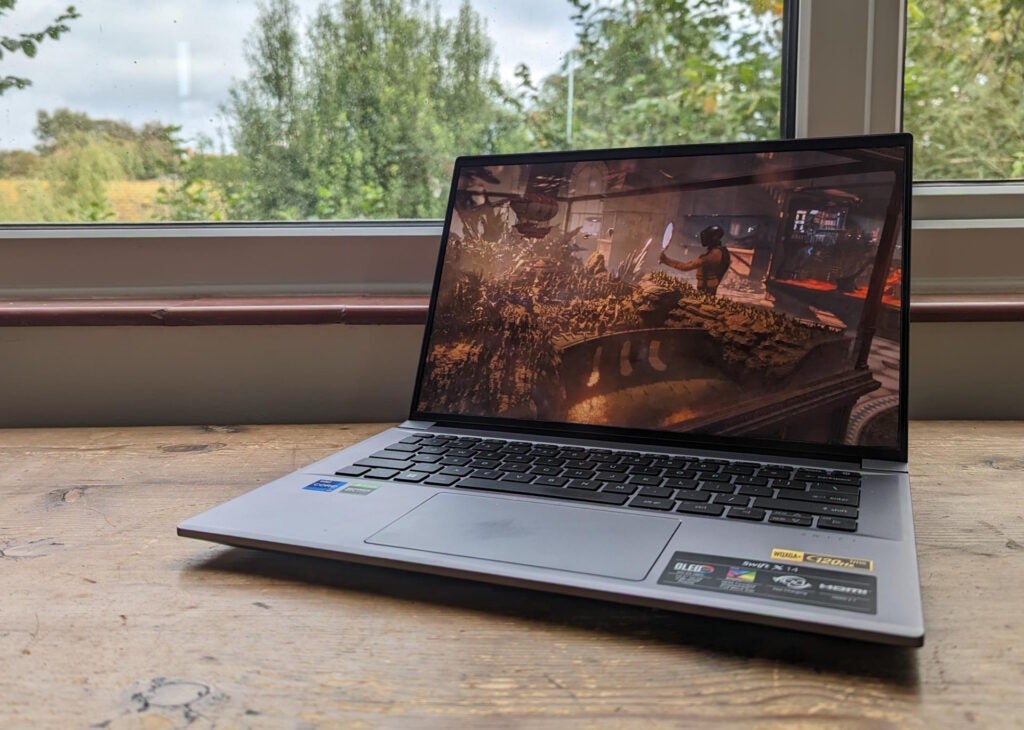
It’s a good-sounding laptop too, delivering richer, rounder audio than you’ll usually get from slimmer, more lightweight models. There’s a little congestion in the mid-range and the sound can become harsh at higher volumes, but there’s a decent stereo spread and that helps make games and movies come alive.
Meetings, calls and video chats won’t be a problem, either. The built-in mic array does a solid job of picking out your voice from any background noise, and the 1080p webcam delivers clear, well-exposed video even in challenging lighting. You may spot a little overexposure near bright windows, but I’ll take that over gloomy and underexposed, any day.
Performance
- Strong performance for creative applications
- Not the fastest laptop with this Core i7 spec
- GPU can handle work and gaming, thanks to DLSS 3
The Swift X 14 has the same Core i7-13700H CPU and 16GB RAM we saw in its close cousin, the Acer Swift Go 14, along with an RTX 4050 GPU, running at a maximum 50W. There’s a 1TB SSD onboard too. It’s a high-performance CPU, with 14 cores running up to 20 threads at speeds of up to 5GHz, depending on the configuration.
Curiously, the Swift X 14 benchmarks a little slower than the Swift Go 14, with Geekbench 6 results of 2275 (single-core) and 8674 (multi-core) to the Swift Go 14’s 2456 and 11724. In PCMark 10, the Swift X 14 posted an overall result of 5895 against the Swift Go’s 6160. It’s also behind some other competitors in Geekbench 6, including the Asus Vivobook S 15 OLED and Zenbook S 13 OLED, though the Swift X 14 is faster than either in PC Mark 10.
The RTX 4050 comes with NVIDIA’s Studio drivers preinstalled, and with its limited wattage is here more to support creative applications than play the latest blockbuster games. Still, as long as you’re realistic, the Swift X 14 will support some gaming after working hours. On Ultra settings in Returnal, you’re looking at 48fps at a 1080p resolution or 33fps at QHD, but you have the choice to turn the detail settings down or use DLSS 3 for a frame rate boost. In QHD this was enough to reach 43fps.
Cyberpunk with ray tracing set to Ultra is a bit much to ask, with the frame rate chugging at 17.92fps at 1080p, dropping to 10.74fps at 1440p. However, you can get 47fps at 1080p on Ultra settings with ray tracing turned off, or you can get a perfectly playable 51.81fps with DLSS 3 and Frame Generation enabled. Be warned, though, that this makes the controls feel ever so slightly laggy.
Software
- Software heavier on upselling than providing useful apps
- Too many trials, not enough tools
Acer and its software partners tend to pre-install a wide selection of apps on Acer laptops, and the Swift X 14 is no exception. There are icons for Dropbox and Booking.com apps on the taskbar, while Acer has its Purified Voice Console and Jumpstart apps sitting in the Start menu. The former is a microphone configuration utility, the latter just a link to Acer’s online store. DTS:X Ultra and DTS Sound Unbound can also be found there, along with WhatsApp, Evernote, an ExpressVPN trial and a link to download the Planet9 gaming client. Most seem to have more to do with marketing opportunities than providing useful tools for the Swift X 14’s target audience.
Battery life
- Battery life might not get you through a full working day
- Expect just over five hours of streaming on a full charge
Battery life is the one area where the Swift X 14 is slightly disappointing. Sure, it’s a powerful laptop with a dedicated graphics chip and a sizable OLED screen, but I’d still hoped for a little more than seven hours and 13 minutes in PC Mark 10’s Modern Office battery benchmark. After all, the Swift Go 14 managed nine hours and 42 minutes, while the Asus Vivobook S OLED 14 lasted for over eleven.
In general use, I found it made it through a working day, but I’d often find levels low and battery warnings kicking in if I needed to do something later in the evening. As a mostly home-based worker, this isn’t an issue for me, but it might be for someone who spends more of their time on the go. As for video streaming, an hour at full brightness saw the charge level drop by 18%, so you should get more than five hours before it runs flat.
Latest deals
Should you buy it?
You need a portable laptop that can handle pro-level creative apps
CPU performance could be better but you’re getting a lot of horsepower in a slim-and-light unit, along with solid ergonomics and an excellent screen. And it doesn’t it hurt that it can also run games.
You need more performance, mobility or battery life
The Swift X 14 is still a compromise, with other laptops offering more speed, a slimmer, lighter design or longer battery life. It gives you a good balance across all three areas, but it’s not quite perfect.
Final Thoughts
The Swift X 14 doesn’t get everything right, but it’s a brilliant laptop for mobile creatives, with a screen and ergonomics you can work with all day long and ample CPU and GPU power. It also comes in a form factor small and light enough that it won’t weigh you down between home and a client, or the office.
There are some other strong options out there, with their own fantastic OLED screens. These include the Asus Zenbook 15 OLED and Zenbook S 13 OLED, not to mention Acer’s own Swift Go 14. Yet none of these offer the same combination of portability, screen quality and dedicated GPU performance, even if each one beats the Swift X 14 in one area or another. This is where Acer’s latest comes out on top, providing everything you’d want for professional design, graphics or video in a package that’s not just practical, but premium in every way. For some more picks, check out our best OLED laptops guide.
How we test
Every laptop we review goes through a series of uniform checks designed to gauge key things, including build quality, performance, screen quality and battery life.
These include formal synthetic benchmarks and scripted tests, plus a series of real-world checks, such as how well it runs popular apps.
We use machines as our main laptop for at least a week.
We test the performance via both benchmark tests and real-world use.
We test the screen with a colorimeter and real-world use.
We test the battery with a benchmark test and real-world use.
FAQs
In simple terms, Aspire is Acer’s budget to mid-range set of laptops whereas Swift focuses on mid-range to high-end laptops.
The Acer Swift X 14 will be overkill for many students, who will be better suited looking at productivity-focused machines. But, if your study involves creative work that benefits from having an accurate display, then this laptop could suit you.
Trusted Reviews test data
PCMark 10
Cinebench R23 multi core
Cinebench R23 single core
Geekbench 5 single core
Geekbench 5 multi core
Geekbench 6 single core
Geekbench 6 multi core
3DMark Time Spy
CrystalDiskMark Read speed
CrystalDiskMark Write Speed
Brightness (SDR)
Black level
Contrast ratio
White Visual Colour Temperature
sRGB
Adobe RGB
DCI-P3
PCMark Battery (office)
Battery discharge after 60 minutes of online Netflix playback
Cyberpunk 2077 (Quad HD)
Cyberpunk 2077 (Full HD)
Cyberpunk 2077 (Full HD + RT)
Cyberpunk 2077 (Full HD + Supersampling)
Returnal (Quad HD)
Returnal (Full HD)
UK RRP
USA RRP
EU RRP
CA RRP
CPU
Manufacturer
Quiet Mark Accredited
Screen Size
Storage Capacity
Front Camera
Battery
Battery Hours
Size (Dimensions)
Weight
Operating System
Release Date
First Reviewed Date
Model Number
Model Variants
Resolution
HDR
Refresh Rate
Ports
GPU
RAM
Connectivity
Colours
Display Technology
Touch Screen
Convertible?
























